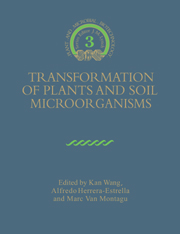Book contents
- Frontmatter
- Contents
- List of Contributors
- Series Preface
- Preface
- Acknowledgements
- Abbreviations and Terms
- Part I Transformation of Soil Microorganisms
- Part II Transformation of Cereal Crops
- 5 Rice Transformation: Methods and Applications
- 6 Maize
- 7 Barley, Wheat, Oat and Other Small-Grain Cereal Crops
- Part III Transformation of Industrially Important Crops
- Index
6 - Maize
Published online by Cambridge University Press: 04 August 2010
- Frontmatter
- Contents
- List of Contributors
- Series Preface
- Preface
- Acknowledgements
- Abbreviations and Terms
- Part I Transformation of Soil Microorganisms
- Part II Transformation of Cereal Crops
- 5 Rice Transformation: Methods and Applications
- 6 Maize
- 7 Barley, Wheat, Oat and Other Small-Grain Cereal Crops
- Part III Transformation of Industrially Important Crops
- Index
Summary
Introduction
Genes advantageous for pathogen or insect resistance, or for enhancing yield, are continuously being sought by plant breeders. Many of these genes exist outside the species targeted for improvement. This fact has led researchers to contemplate ways of overcoming the biological barriers to gene transfer. More than a quarter of a century has passed since the first attempt was made to introduce DNA into maize (Zea mays) through physical intervention (Coe & Sarkar, 1966). Although this attempt, which involved direct injection of DNA into apical meristems of seeds, was not successful, it did serve to identify a principal problem – namely that ‘The cell wall, a massive barrier to large structures, may have to be disrupted mechanically or chemically, or otherwise circumvented’. Another observation made in 1966 by Coe & Sarkar was that ‘the number of meristem cells actually penetrated and observed may be too small to have included a fortuitous, observable transformation’. Over two decades later the efficient combination of DNA delivery and transformed cell selection has proved to be the key to production of transgenic plants of all species and particularly of maize, which as a cereal of major commercial importance has attracted substantial attention in recent years.
Maize transformation, defined as the production of transgenic plants that are fertile and produce transgenic seed, was achieved for the first time in 1990 (Fromm et al., 1990; Gordon-Kamm et al. 1990). Since then a number of commercial research groups have conducted field trials of transgenic maize, demonstrating the attainment of more widespread success.
- Type
- Chapter
- Information
- Transformation of Plants and Soil Microorganisms , pp. 65 - 80Publisher: Cambridge University PressPrint publication year: 1995
- 2
- Cited by



